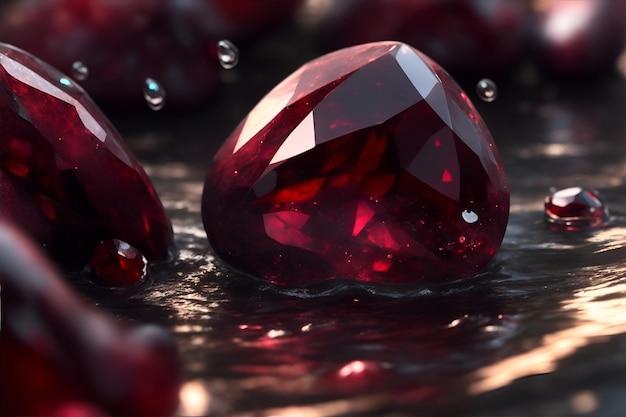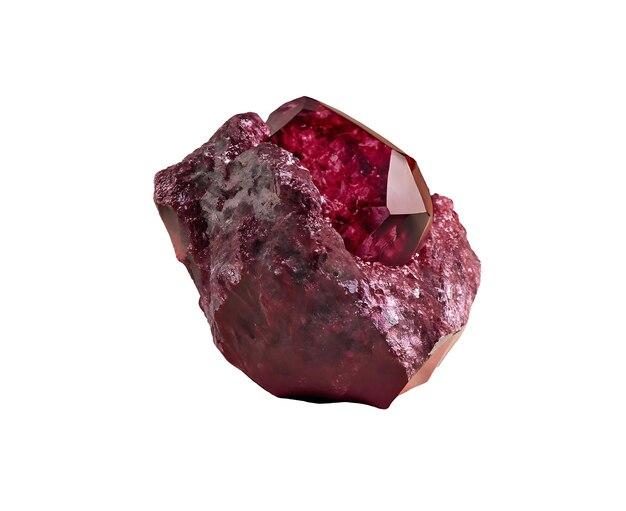Rubies, with their deep red hue and captivating sparkle, have been highly sought after for centuries. But have you ever wondered what rubies look like in their natural state? In this blog post, we’ll explore the characteristics of natural rubies and answer some commonly asked questions about these magnificent gemstones.
Many people associate rubies with a vibrant red color, but did you know that natural rubies can actually range in color from pink to deep red? The intensity of the color is determined by the presence of certain minerals, such as chromium, in the gemstone. These minerals give rubies their rich and captivating hues.
While red is the most common color for rubies, there are also variations such as pinkish-red and purplish-red. In fact, the finest rubies are often described as having a “pigeon blood” color, which is an intense and pure red with a hint of blue. These exquisite gems are highly valued and can command premium prices in the market.
So, if you’re curious to learn more about rubies in their natural state and discover some fascinating insights, keep reading! We’ll delve into topics like the differences between rubies and other gemstones, where the best rubies are found, and much more.

What do rubies look like in their natural state?
Rubies, those magnificent gems known for their vibrant red color, are truly a sight to behold in their natural state. When you stumble upon a raw ruby, you can’t help but marvel at its beauty and wonder how Mother Nature managed to create such a gem. So, let’s dive into the fascinating world of natural rubies and explore what they really look like.
The Radiant Red Jewel
In their natural state, rubies showcase a mesmerizing hue of red, reminiscent of a passionate flame or a heart on fire. It’s no wonder they’re often associated with love and desire. Picture a sunset painted with the deepest shades of crimson and garnet, and that’s how these precious stones captivate the eye. Rubies have a way of commanding attention and stealing the spotlight, leaving other gems green with envy.
Crystal Clarity
Don’t be fooled by their intense color; rubies are actually a variety of the mineral corundum, just like their blue siblings, sapphires. But what sets rubies apart is their rich red pigment. These gems form in hexagonal crystals, which give them their distinct shape and structure. When you hold a raw ruby up to the light, you’ll witness its transparent to translucent nature, allowing light to dance and refract within its depths.
The Size Myth
Unlike diamonds, rubies aren’t commonly found in large sizes. In fact, raw rubies are usually quite small, often measuring only a few centimeters in diameter. But don’t let their petite appearance fool you; these little gems pack a powerful punch. It’s not about the size; it’s about the vibrant energy they radiate and the stories they hold within.
Nature’s Imperfections
Just like us humans, rubies come with their fair share of flaws. But fret not, for it’s these imperfections that make them all the more unique and endearing. These natural inclusions, such as tiny crystals or other minerals, can sometimes be seen within the gemstone. But hey, who said perfection was all it’s cracked up to be? Embrace the quirks and celebrate the character that Mother Nature has bestowed upon each ruby.
Cutting a Legacy
While raw rubies may be captivating in their natural state, it’s the expert craftsmanship of skilled lapidaries that truly brings out their brilliance. With precision and artistry, these master cutters transform rough gems into mesmerizing facets that dance and sparkle with every flicker of light. From traditional shapes like ovals and cushions to more avant-garde designs, each cut has the power to enhance the ruby’s radiance and charm.
A World of Possibilities
So, what do rubies look like in their natural state? They are fiery, crimson wonders that capture the essence of passion and romance. Their transparent to translucent bodies reveal inner worlds of crystal clarity, while their imperfections add a touch of authenticity. Whether in their raw form or expertly cut and polished, rubies are nature’s way of reminding us to embrace our own unique beauty and let our true colors shine.
Now, grab a cup of tea, imagine yourself lost in a ruby forest, and let the magic of these exquisite gemstones infuse your dreams with splendor.

FAQ: What do rubies look like in their natural state?
What color is a natural ruby
A natural ruby exhibits a vivid shade of red, often described as a “pigeon blood red.” This intense hue is a result of the presence of chromium in the mineral composition of the ruby.
Are there black rubies
Contrary to popular belief, rubies do not occur naturally in black color. While a ruby may exhibit deep red or purplish tones, it should not be mistaken for a black ruby.
How do you tell the difference between a ruby and a sapphire
Distinguishing between a ruby and a sapphire can be quite a challenge, even for experts. The primary difference lies in their color. Rubies are renowned for their red shade, while sapphires come in a spectrum of colors, except red.
Where are the best rubies found
The most exquisite rubies are found in the legendary mines of Myanmar (formerly Burma), particularly the region of Mogok. These rubies are highly coveted for their exceptional color and clarity.
Are rubies cloudy
No, genuine rubies should not appear cloudy. In fact, one of the significant factors determining a ruby’s quality is its clarity, which refers to the absence of inclusions or cloudiness within the gemstone.
Which is more expensive, a ruby or a garnet
Rubies tend to be more expensive than garnets. The mesmerizing red hue and exceptional rarity of rubies contribute to their higher value in the gemstone market.
Do real rubies have bubbles
No, real rubies should not have visible bubbles inside them. Bubbles are usually a sign of synthetic or imitation rubies. Authentic rubies are known for their remarkable clarity and lack of internal imperfections.
What does ruby look like in the ground
In its natural state, rubies appear as small, rough crystals embedded within rocks or minerals. These uncut rubies may not possess the characteristic deep red color associated with their polished counterparts, but they still possess the potential for exceptional beauty.
What rocks are rubies found in
Rubies are commonly found in metamorphic rocks, specifically those formed under high pressure and temperature conditions. Some examples of these rocks include marble, basalt, gneiss, and schist.
What is pigeon blood ruby
“Pigeon blood ruby” refers to the finest quality rubies with an exquisite, deep red color. The term originated from the belief that the color closely resembles the blood of a pigeon. A true pigeon blood ruby is highly sought after and considered incredibly valuable.
How do you tell if my rock is a ruby
To determine if a rock is a ruby, you can perform a few tests. First, check for its hardness. Rubies have a hardness of 9 on the Mohs scale, making them one of the most durable gemstones. Additionally, inspect its color and luster. The vibrant red color and intense glow are indicative of a potential ruby.
Do green rubies exist
While there is no such thing as a “green ruby,” certain rare varieties of corundum, the mineral family to which rubies belong, are green. These green gems, known as green sapphires, possess their own unique charm and desirability.
How do you remove rubies from rocks
Extracting rubies from their rocky matrix requires precision and expertise. Miners use various techniques, including drilling, blasting, and careful excavation, to extract the ruby-bearing rocks. Afterward, the rubies are meticulously separated and prepared for the gemstone market.
How do you tell if it’s a ruby or garnet
Differentiating between a ruby and a garnet can be challenging since they can exhibit similar shades of red. However, a trained gemologist can use several methods, such as observing the refractive index, density, and spectral analysis, to accurately identify the gemstone.
How do you identify a natural ruby
Identifying a natural ruby involves examining several key characteristics. A genuine ruby should display a strong red hue, exhibit excellent hardness, possess exceptional clarity, and show fluorescence, usually with a red hue, when exposed to ultraviolet light.
What color does ruby fluorescence
Rubies typically exhibit fluorescence when exposed to ultraviolet (UV) light. Under UV light, a natural ruby may fluoresce in shades of bright red, pink, or orange. This fluorescence can help gemologists and enthusiasts identify and authenticate genuine rubies.
Do rubies glow under black light
Yes, rubies can emit a vibrant glow under black light. This phenomenon, known as fluorescence, can vary in intensity and color, usually appearing as a captivating red, pink, or orange glow.
Are rubies just red sapphires
Technically speaking, both rubies and sapphires belong to the corundum mineral family. However, sapphires encompass all colors except red, while rubies are specifically red corundum. So, while rubies can be seen as a type of sapphire, the term “ruby” is used exclusively for red corundum.
What is the difference in color between a ruby and a garnet
When comparing rubies and garnets, the primary difference lies in their hue. While both gemstones may display shades of red, rubies exhibit a vibrant, intense red, often with a hint of blue undertones, whereas garnets often have a deeper, reddish-brown color.
How can you tell a natural ruby from synthetic
Distinguishing between a natural ruby and a synthetic one can be quite challenging. However, an experienced gemologist can utilize various techniques, such as observing growth patterns, analyzing inclusions, and assessing the presence of certain minerals, to determine the origin of the gemstone.
How can you tell a real garnet from a fake
To distinguish a real garnet from a fake, one can examine certain characteristics. Real garnets possess a distinct crystal structure, display a specific range of colors, and exhibit signs of wear over time. Additionally, a gemological analysis or consultation with an expert can help confirm its authenticity.
What stone looks like a ruby
Several gemstones bear a resemblance to rubies, but one particularly striking alternative is a red spinel. Red spinels can possess a similar shade of red and can easily be mistaken for rubies. However, their composition and properties differ from those of genuine rubies.